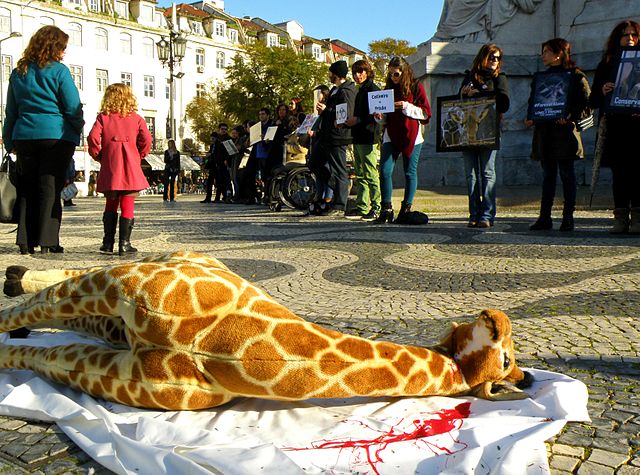By Lori Gruen
The decision by the administrators of the Copenhagen Zoo to kill a two-year-old giraffe named Marius by shooting him in the head in February 2014, then autopsy his body in public and feed Marius’ body parts to the lions held captive at the zoo created quite an uproar. When the same zoo then killed the lions (an adult pair and their two cubs) a month later to make room for a more genetically-worthy captive, the uproar became more ferocious.
Animal lovers across the globe were shocked and sickened by these killings and couldn’t understand why this bloodshed was being carried out at a zoo.
The zoo’s justification for killing Marius was that he had genes that were already “well represented” in the captive giraffe population in Europe. The justification for killing the lions was that the zoo was planning to introduce a younger male who was not genetically related to any of the females in the group.
Sacrificing the well-being and even the lives of individual animals in the name of conserving a diverse gene pool is commonplace in zoos. Euthanasia, usually by means less grotesque than a shotgun to the head, is quite common in European zoos. In US zoos, contraception is often used to prevent “over-representation” of certain gene lines. The European zoos’ reason for not using birth control the way most American zoos do is that they believe allowing animals to reproduce provides the animals with the opportunity to engage the fuller range of species typical behaviors, but that also means killing the undesirable offspring. In both European and US zoos, families are broken up and individuals are shipped to other facilities to diversify and manage the captive gene pool.
If this all has a ring of eugenic reasoning, consider what the executive director of the World Association of Zoos and Aquariums, Gerald Dick, had to say: “In Europe, there is a strict attempt to maintain genetically pure animals and not waste space in a zoo for genetically useless specimens.”

A stuffed giraffe, representing Marius, at a protest against zoos and the confinement of animals in Lisbon, 2014
The high-profile slaughter of Marius and the lions that ate his body focus attention on an important debate about the purpose of zoos and more generally the ethics of captivity. Originally, zoos were designed to amuse, amaze, and entertain visitors. As public awareness of the plight of endangered species and their diminishing habitats grew, zoos increasingly saw their roles as conservation and education. But just what is being conserved and what are the educational lessons that zoo-goers take away from their experiences at the zoo?
A recent study suggests that zoo-goers learn about biodiversity by visiting zoos. Critics have suggested that the study is not particularly convincing in linking the small increase in understanding of biodiversity with the complex demands of conservation. Some zoos are committed to direct conservation efforts; the Wildlife Conservation Society (aka the Bronx Zoo) and the Lincoln Park Zoo are just two examples of zoos that have extensive and successful conservation programs. Despite these laudable programs, these WAZA-accredited zoos, like the European zoos, are also in the business of gene management and a central tenet of the current management ethos is to value genetic diversity over individual well-being.
Awe-inspiring animals such as giraffes and gorillas and cheetahs and chimpanzees are not seen as individuals, with distinct perspectives, when viewed, as Dick says, as either useful or useless “specimens.” They are valued, if at all, as representative carriers of their species’ genes.
This distorts our understanding of other animals and our relationships to them. Part of the problem is that zoos are not places in which animals can be seen as dignified. Zoos are designed to satisfy human interests and desires, even though they largely fail at this. A trip to the zoo creates a relationship in which the observer, often a child, has a feeling of dominant distance over the animals being looked at. It is hard to respect and admire a being that is captive in every respect and viewed as a disposable specimen, one who can be killed to satisfy a mission that is hard for the zoo-going public to fully understand, let alone endorse.
Causing death is what zoos do. It is not all that they do, but it is a big part of what happens at zoos, even if this is usually hidden from the public. Zoos are institutions that not only purposely kill animals, they are also places that in holding certain animals captive, shorten their lives. Some animals, such as elephants and orca whales, cannot thrive in captivity and holding them in zoos and aquaria causes them to die prematurely.
Death is a natural part of life, and perhaps we would do well to have a less fearful, more accepting attitude about death. But those who purposefully bring about premature death run the risk of perpetuating the notion that some lives are disposable. It is that very idea that we can use and dispose of other animals as we please that has led to the problems that have zoos and others thinking about conservation in the first place. When institutions of captivity promote the idea that some animals are disposable by killing “genetically useless specimens” like young Marius and the lions, they may very well be undermining the tenuous conservation claims that are meant to justify their existence.
Lori Gruen is Professor of Philosophy, Feminist, Gender, and Sexuality Studies, and Environmental Studies at Wesleyan University where she also coordinates Wesleyan Animal Studies and directs the Ethics in Society Project. She is the author of The Ethics of Captivity.
Subscribe to the OUPblog via email or RSS.
Subscribe to only philosophy articles on the OUPblog via email or RSS.
Image credit: Sit-in protest in Lisbon. Photo by Mattia Luigi Nappi, 2014. CC-BY-SA-3.0 via Wikimedia Commons
The post Disposable captives appeared first on OUPblog.


